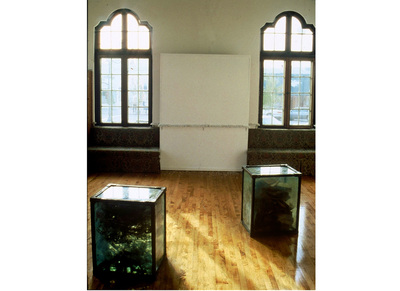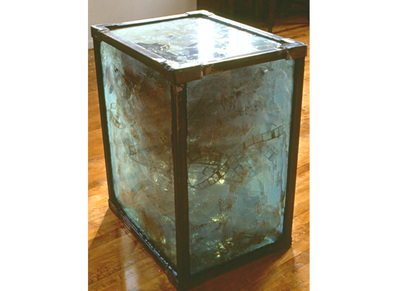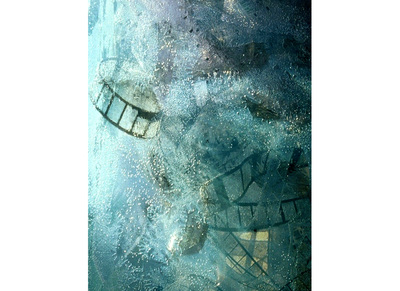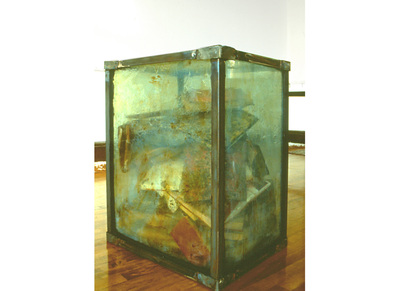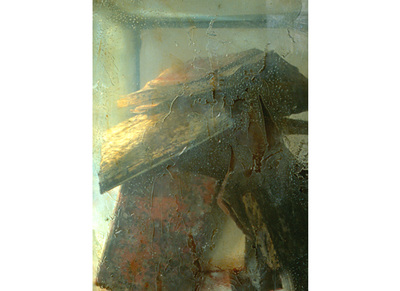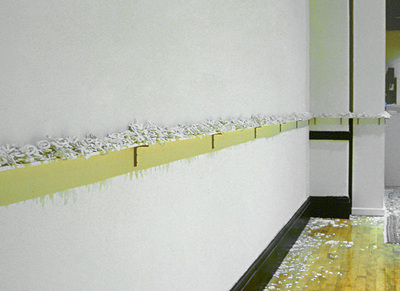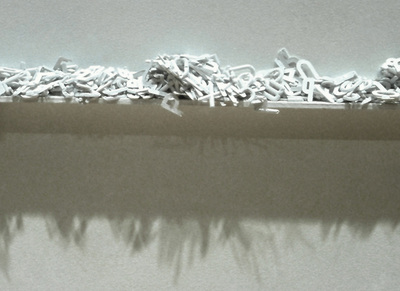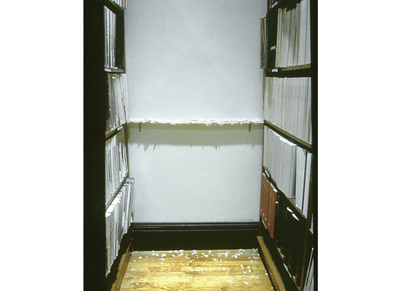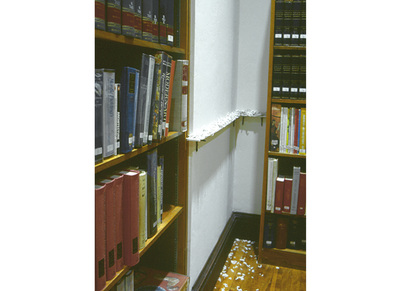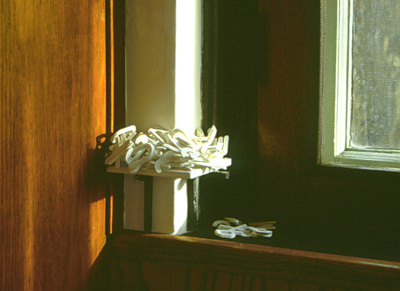TOO THICK to CHEW the Aphasic Works '93 collaboration with Richard Keely, Athenaeum Music & Arts Library, LaJolla, CA
TOO THICK to CHEW the Aphasic Works
a pha' si a .... the total or partial loss of the ability to use or understand words
In considering a piece for the Athenaeum, we felt compelled to draw from the substance of the library itself. TOO THICK TO CHEW comments on the dilemma of contemporary society in storing rapidly increasing volumes of information, and on the inevitable loss of the essence of an artwork within these modern-day storage systems.
We appreciate and recognize the importance of a music and arts library, but we also find an irony in the attempt to try and record and categorize these art forms. The personal and experiential nature of an artistic endeavor is difficult, if not impossible, to transfer to printed material without sacrificing that indefinable quality that designates a work of art. Having lost the ability to understand words, aphasic patients tend to relate to their new-found world through sensory realms of texture, color and form. In this same way, this installation attempts to sensitize the very elements that act to desensitize the works the library is compelled to keep.
read about Aphasia
a pha' si a .... the total or partial loss of the ability to use or understand words
In considering a piece for the Athenaeum, we felt compelled to draw from the substance of the library itself. TOO THICK TO CHEW comments on the dilemma of contemporary society in storing rapidly increasing volumes of information, and on the inevitable loss of the essence of an artwork within these modern-day storage systems.
We appreciate and recognize the importance of a music and arts library, but we also find an irony in the attempt to try and record and categorize these art forms. The personal and experiential nature of an artistic endeavor is difficult, if not impossible, to transfer to printed material without sacrificing that indefinable quality that designates a work of art. Having lost the ability to understand words, aphasic patients tend to relate to their new-found world through sensory realms of texture, color and form. In this same way, this installation attempts to sensitize the very elements that act to desensitize the works the library is compelled to keep.
read about Aphasia
DESCRIPTION
Two large sealed glass tanks held microfilm suspended in water (1), and colorfully molded books (2). A thin wooden shelf traced the entire interior of the library space, and was ‘over-filled’ with thousands of plaster-cast letters.
Metaphorically, we made 'volumes' of language - the letters - that could not be accommodated on a 'too-narrow' support system of shelving that was inadequate to hold it. The language then became vulnerable as it fell to the floor and broke, making a mess that was often in the way.
The APHASIC WORKS series is a parallel to the medical condition of Aphasia - a type of brain trauma - as it addresses the loss of the ability to communicate with words. Although their minds are in tact, many Aphasics relate to their world through the senses. Thus, in this installation, the substance of the library - books and microfilm - were translated into the sensual experience of texture and color.
An additional parallel highlights the 'condition' of the artist, whose world is similarly dictated by visual and sensual interpretation.
review: ROBERT PINCUS
Athenaeum interview: MARIE HORN
Two large sealed glass tanks held microfilm suspended in water (1), and colorfully molded books (2). A thin wooden shelf traced the entire interior of the library space, and was ‘over-filled’ with thousands of plaster-cast letters.
Metaphorically, we made 'volumes' of language - the letters - that could not be accommodated on a 'too-narrow' support system of shelving that was inadequate to hold it. The language then became vulnerable as it fell to the floor and broke, making a mess that was often in the way.
The APHASIC WORKS series is a parallel to the medical condition of Aphasia - a type of brain trauma - as it addresses the loss of the ability to communicate with words. Although their minds are in tact, many Aphasics relate to their world through the senses. Thus, in this installation, the substance of the library - books and microfilm - were translated into the sensual experience of texture and color.
An additional parallel highlights the 'condition' of the artist, whose world is similarly dictated by visual and sensual interpretation.
review: ROBERT PINCUS
Athenaeum interview: MARIE HORN
